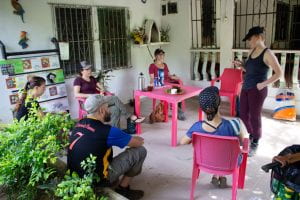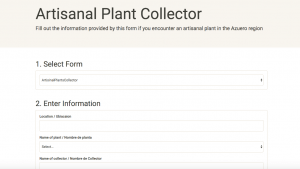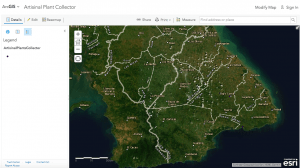One of my deliverables to National Geographic will be a map of accessible artisanal plants in the Azuero Peninsula. The goal of creating the Artisanal Map is to provide an accessible source for the artisans of the Azuero Peninsula so that they can easily find and acquire natural artisanal fibers, dyes, and seeds. I want to create an easy to use map that can be viewed online and printed on paper. As well, I want to create an easy way to map out the plants, so that any user can do it themselves.
Using ArchGIS Julia, one of the other volunteers, created a geoform that allows anyone with internet access and a phone to fill out the form and map an artisanal plant that they may discover. The form is in both Spanish and english so everyone can add data to the map. Data points can also be added while offline using the collector app through ArchGIS. However, you must have a user login to use the app and add data offline. So we created 6 temporary users for the Peace Corps volunteers to use.  On June 25th, I traveled around the peninsula to meet with different Peace Corps volunteers to teach them how to use the app. This way we will be able to map artisanal plants in 6 towns of the Peninsula: Bajo Corral, La Miel, Nuario, Valleriquito, Bayano, and Partilla. Luckily, 4 of them were in La Miel doing some reforestation work together. I was able to teach them how to use the app. In addition, I created a tutorial document so anyone in the future can read it and know exactly how to use the app. The plan is for them to go around town asking artisans where to find certain artisanal plants. Hopefully in the next few weeks they will begin adding points to the map.
On June 25th, I traveled around the peninsula to meet with different Peace Corps volunteers to teach them how to use the app. This way we will be able to map artisanal plants in 6 towns of the Peninsula: Bajo Corral, La Miel, Nuario, Valleriquito, Bayano, and Partilla. Luckily, 4 of them were in La Miel doing some reforestation work together. I was able to teach them how to use the app. In addition, I created a tutorial document so anyone in the future can read it and know exactly how to use the app. The plan is for them to go around town asking artisans where to find certain artisanal plants. Hopefully in the next few weeks they will begin adding points to the map.
Each data point on the map contains vital information about the plant. It includes the name of the town and landowners of where the plant can be found. The name of the plant is chosen from a list of already discovered plants. If it is a new plant or it does not appear on the list, the collector will add the name of the plant in the notes. The name of the collector, the date, the habitat surrounding the plant, and the seeding period are also collected. You must choose whether it is cultivated or wild. Lastly, there is an option to note whether the plant was planted as a part of the Eco-Artisan project with Azuero Earth Project.
There is also a section to take pictures and videos and add them to the data point. Ideally, collectors will get a picture of any identifying characteristics of the plant (seeds, leaves, ect), the plant and its surrounding habitat, or any other identifying mark to help artisans locate the plant. If a new plant is discovered, the collectors can upload a video of an artisan explaining how to harvest and/or cultivate the new species.
All of this information will be useful to both the artisans individually, but also the Eco-Artisan Association as a whole. The information collected contributes to the guide on how to sustainably cultivate and harvest artisanal plants. It will help the artisans understand when and where to collect the plants and how to identify them. Overall, it will meet the goal of creating an accessible source for the Eco-Artisans to better sustainably and safely create their artisan handicrafts in the future.



